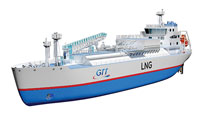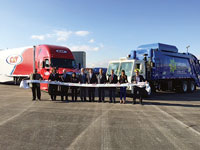New in gas processing technology
A. Blume, Editor
Bunkering ship concept approved
 |
Classification society Bureau Veritas (BV) has granted approval in principle (AIP) to a 4,000-m3 bunkering ship concept developed by French LNG containment manufacturer GTT. The concept is for a bunker tanker that could deliver LNG as ship fuel, using tanks with a GTT Mark III Flex cargo containment system of up to 2 barg.
Combining the membrane containment system with the ability to store LNG at pressures up to 2 barg allow the bunker vessel to have a higher capacity and increased operational flexibility.
The pressurized membrane tank concept means that LNG bunker tankers can manage boiloff gas (BOG) better, and increase loading and delivery flowrates.
Under GTT’s system, BOG management during loading and bunkering operations is made more flexible because of the wide vapor pressure operating range. Vapor can be buffered and condensed in the tanks to help the fueled ship or feeding facility handle the vapor.
Condensation may be performed by spraying LNG into the vapor phase. The higher pressure also means that, during voyage and standby mode, a longer duration is seen before
gas pressure in the bunker tanker’s tanks reaches the upper limit. This improves the holding time when BOG is not being consumed and reduces the use of the reliquefaction plant, thereby diminishing costs.
Optical sensor for gas analysis
 |
Gas composition can change as LNG undergoes treatment and transportation; unaccounted-for changes will negatively impact downstream operations, such as refining and power generation. Therefore, LNG composition must be measured at many points in the supply chain, including gas pretreatment facilities, LNG export and import locations, storage tanks, and vaporization/condensation facilities. Fast, online hydrocarbon composition analysis for C1–C5 alkanes (methane, ethane, propane, etc.) is needed to determine gas quality in LNG transport applications.
Gas chromatography (GC) has been the dominant analytical tool for the speciation and compositional analysis of C1–C5 hydrocarbon gas mixtures. GC analytical measurements require between 90 sec and 5 min, and a continuous supply of high-purity carrier gas. As well, the comparative nature of GC requires regular calibration of the analyzer. These characteristics make online deployment of GC tools difficult at best, and frequently impossible.
Infrared (IR) spectroscopy is an optical technique that measures the wavelength-dependent absorption of infrared light passing through a sample, and then uses the absorption data to determine sample speciation and composition. It has a long and successful history in industrial online gas/liquid measurement applications.
IR spectroscopy is fast (seconds or sub-second measurement time) and provides a direct, first-principles (not comparative or correlative) measurement by using simple, flowthrough sampling configurations that do not require carrier gas or other consumables. These characteristics make it eminently suitable for online analytical applications.
At present, IR spectrometers that use discrete optical filter elements (known as nondispersive infrared, or NDIR, spectrometers) are widely used in online applications. NDIR analyzers are robust and effective analytical tools; however, they are not capable of differentiating or speciating hydrocarbon mixtures, such as those in LNG, due to the fact that compound-specific IR absorptions strongly overlap in such mixtures.
MKS Instruments has introduced an improvement to conventional NDIR instrumentation: Precisive TFS Tunable Filter Spectroscopy. TFS uses a proprietary tunable Fabry-Perot optical assembly to enable wavelength scanning in preselected regions, coupled with a chemometric-based pattern-recognition algorithm that deconvolves and quantifies multi-component spectra, such as those existing in LNG spectra.
This TFS “engine” has been implemented in the new, standalone Precisive 5 hydrocarbon gas analyzer, available in a NEMA4X, IP66-rated, Division 2-/Zone 2-certified enclosure for use in various natural gas processing applications. It provides speciated concentration values for methane, ethane, propane, iso-butane, n-butane and pentanes, and uses this data to report calorific values and Wobbe indices for the analyte gas. Optional CO2 and H2S direct measurement channels are also available. The Precisive 5 analyzer is permanently calibrated; requires no consumable gas; and can sample gas at a wide range of pressures, temperatures and flowrates.
Gas-block terminal design approved
ABS has granted approval in principle (AIP) for the design of the China National Offshore Oil Co. (CNOOC) Gas-Block (CGB) terminal.
The CGB unit functions as an offshore LNG receiving, storage, regasification and bunkering terminal, comprising a concrete caisson structure with a steel roof and steel skirt. The overall structure includes the caisson deck, external transverse bulkheads and external longitudinal bulkheads.
The terminal will house horizontal LNG storage Type C tanks and additional processing equipment topside. It is expected to be installed on the seabed with a design water depth of 10 m to 20 m. The storage volume of a single block can vary from 5,000 m3 to 50,000 m3, and the total storage volume can be up to 300,000 m3 when several blocks are combined.
According to CNOOC Gas and Power Group, the CGB terminal offers a number of advantages, including modularized construction and installation. The hull, LNG tanks and topside facility can be constructed in a dry dock and then wet-towed to the installation site.
Since the steel skirt can be lowered onto and extracted from the seabed, the terminal can be easily relocated from one site to another. Designed-in safety means that the concrete box is capable of sustaining LNG liquid in case of tank leakage, and it features a high load-carrying capacity against wind, wave, current and seismic loads.
The AIP scope for the CGB terminal concept included reviewing the feasibility of the structural design of the equipped concrete hull and the global performance in accordance with ABS rules and guidelines for gravity-based LNG terminals. It also provides the parallel main structure analysis of the terminal hull for construction, transportation, operations, seismic, and accidental LNG leaking loading conditions.
ABS has been supporting clients involved in gas-related projects—including LNG and LPG transportation, LNG and LPG as fuel, and emerging offshore LNG terminal technology projects—for more than 60 years.
Order received for small-scale LNG
The Dresser-Rand business within Siemens Power and Gas recently received an order from Elizabethtown Gas for two LNGo natural gas liquefaction systems. The order includes installation and commissioning at the Elizabethtown Gas site. The systems will be sized to produce approximately 13,500 gpd of LNG.
Dresser-Rand’s LNGo natural gas liquefaction system is a modularized, portable LNG plant designed to provide onsite liquefaction. This point-of-use production plant is a standardized product made up of four packaged skids: a power module, a compressor module, a process module and a conditioning module.
LNGo natural gas conversion plants enable the distributed production of LNG on a small scale. The technology eliminates the need for the costly trucking of LNG long distances.
Canada opens largest CNG station
 |
An Emterra compressed natural gas (CNG) truck cut the ribbon during the grand opening ceremony, in late October 2015, for the new GAIN Clean Fuel CNG station located in Mississauga, Ontario, Canada. It is the largest public CNG station in the country and was built through a partnership among C.A.T. Inc., Emterra and US Venture Gain Fuel Canada ULC, which owns the GAIN Clean Fuel brand.
The station will fuel C.A.T.’s fleet of 100 CNG trucks and Emterra’s fleet of more than 100 vehicles. All GAIN Clean Fuel stations are said to provide easy-access, fast-fill capabilities.
Sealing parts for gas sweetening
Today, refineries and gas plants around the world are processing crude oil and natural (sour) gas containing higher concentrations of hydrogen sulfide (H2S) than ever before. At the same time, global environmental standards demand progressive reduction of H2S content in gas- and oil-based end products. As a result, the hot amine “sweetening” treatments used to remove H2S are becoming much more aggressive to the materials used to seal pumps, valves and other vital process equipment—to the extent that commonly used fluoroelastomer (FKM) and perfluoroelastomer (FFKM) seals are failing more frequently, risking toxic leakage and potentially costly downtime.
DuPont Kalrez Spectrum 6380 perfluoroelastomer sealing parts are said to offer outstanding resistance to amines and strong oxidizers at high temperatures in gas sweetening processes. The Kalrez Spectrum 6380 parts exhibit 10 to 15 times lower swell than FKM, and four times lower swell than general-purpose FFKM, in such environments.
A major chemical company in France, processing a mix of amines, ethylene oxide and other chemicals at 150°C, has reported a seven times longer seal lifetime when switching to a Kalrez Spectrum 6380 O-ring from a competitive broad-resistance FFKM-grade O-ring. In this actual case history example, the conventional FFKM O-ring survived the hazardous and highly aggressive process conditions for only 15 days before requiring replacement, while the Kalrez Spectrum 6380 part survived for 3.5 months.
According to the company, the benefits of installing Kalrez Spectrum 6380 parts have been seen in increased system efficiency, significantly extended mean time between repairs (MTBR), greater reliability, and enhanced safety from the reduced risk of potentially dangerous chemical leaks. Ultimately, this has led to valuable annual savings in reduced total system cost.
The use of the Kalrez Spectrum 6380 parts in amine gas sweetening applications can extend mean time between repair for valves and mechanical pump seals, reduce leakage and contribute to reduced maintenance costs and lower emissions. Furthermore, the Kalrez 0090 parts represent another option for this application when high pressure resistance is needed. In laboratory testing for rapid gas decompression resistance, Kalrez AS568-312 O-rings received the best possible rating as per the NORSOK M-710 Revision 2 standard.




Comments